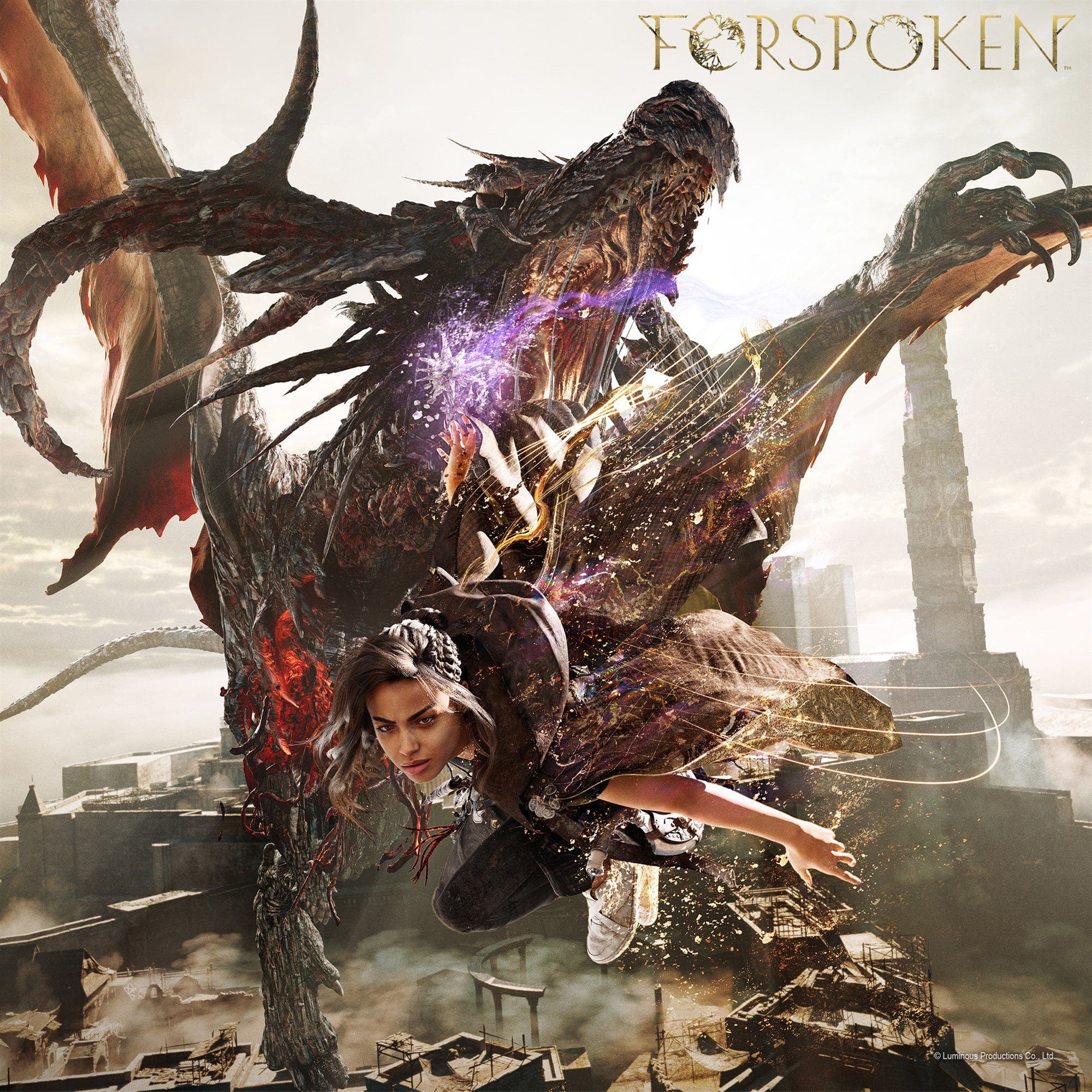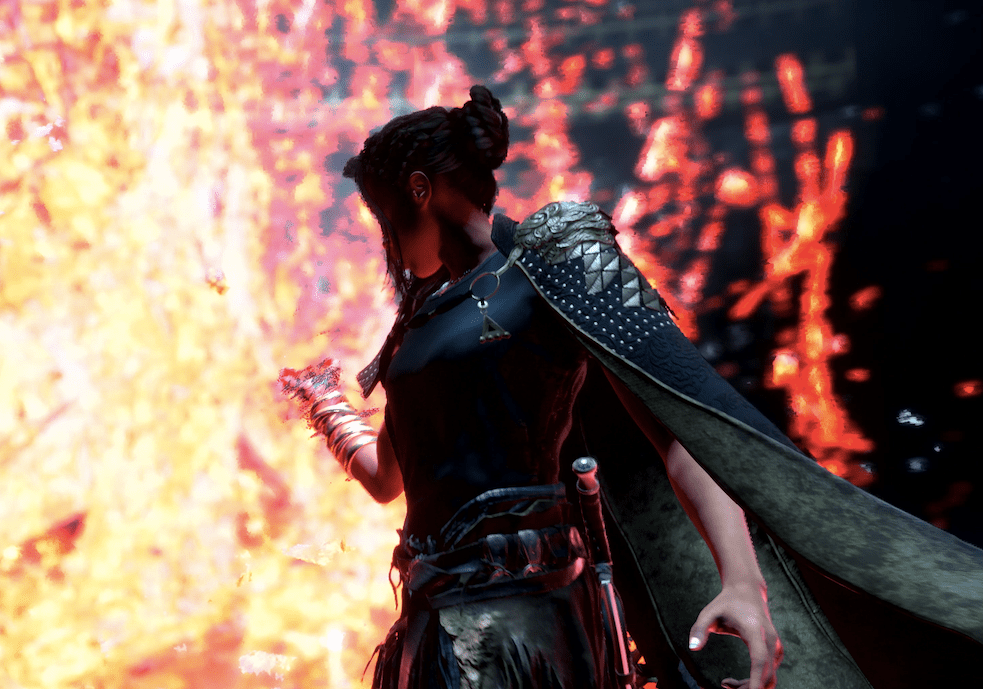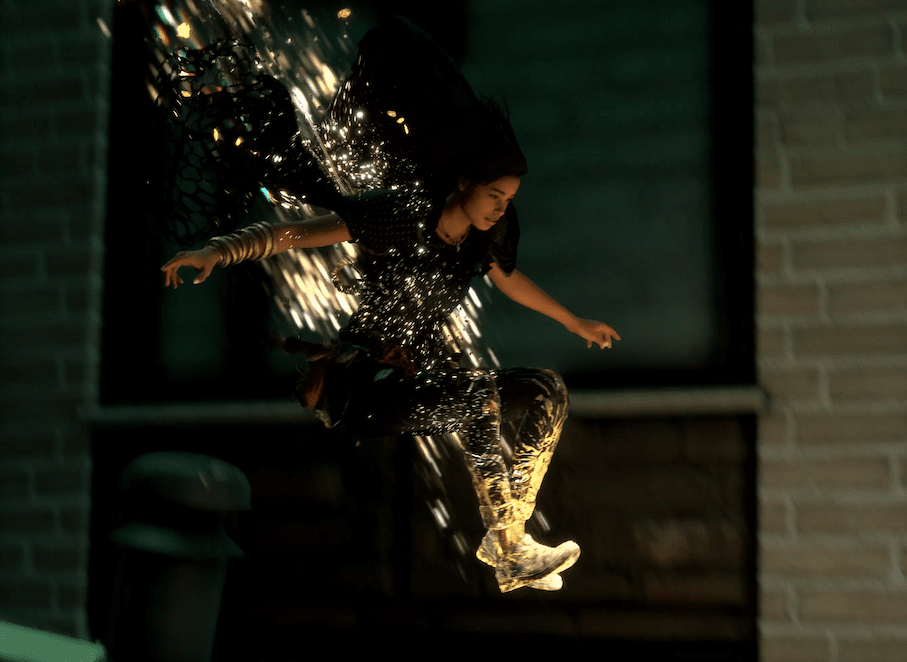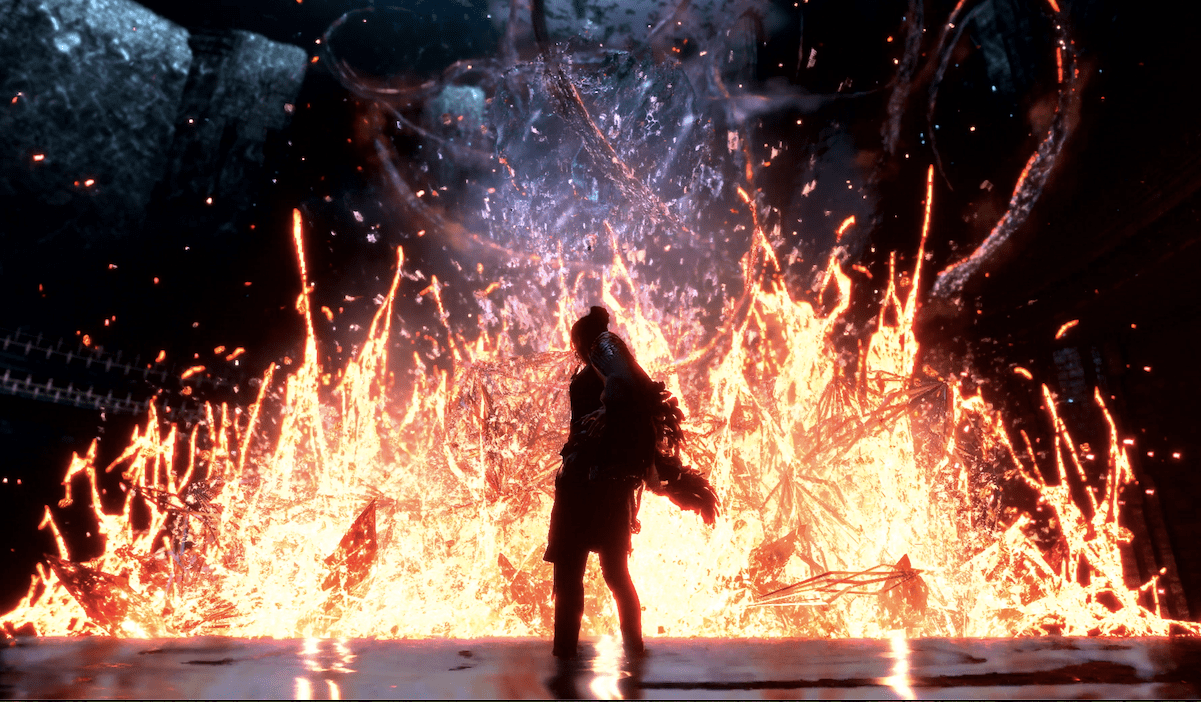
The newest action-RPG from Square Enix and the first game from Luminous Productions, who assisted Final Fantasy XV’s development, Forspoken, showcases the kind of ambition any true next-gen experience should have, but is weighed down by narrative and presentation shortcomings.
The game sees players take the role of Frey Holland (voiced by Ella Balinska), a young woman in New York City struggling with homelessness and finding her place in the world since being abandoned as a baby. Frey often finds herself in trouble with the law more than she does moving forward in her life and now dreams of escape, which she gains in an unexpected way. After seeing this strange looking cuff one day, Frey is transported into the high fantasy world of Athia. Here, a fearsome dragon roams the skies and the citizens of the royal city of Cipal are harshly ruled by the magic wielding Tantas. With Frey not only finding that her cuff (voiced by Jonathan Cake) can talk, but also that she possesses magical abilities of her own, Frey goes on a journey to defeat the Tantas to restore peace while also discovering hidden parts of her own self.
When Forspoken was first shown, it was dubbed as an experience specifically built for the PS5, meaning that it was outwardly defining itself as next-gen. A bold claim for sure, but one that Forspoken lives up to well within just the basic aspects of its gameplay experience. Athia might be the most expansive map I’ve ever seen in a game before with its varying landscapes and huge size making it a fantasy playground like no other. There are gigantic mountains to scale and intriguing depths to explore. Plus, there are plenty of big enemy encounters and activities littered throughout the world that players can do to get big rewards. Admittedly, some of the side activities can become repetitive and often task players with simply defeating enemies, but they’re easily addicting and it’s one of the ways that Forspoken has some shared DNA with Final Fantasy XV.

Even if you didn’t know that Luminous worked on Final Fantasy XV, you get the hunch that they might have at least been inspired by the game. The idea of Frey taking photos of major landmarks she sees to show to some children from Cipal and getting pivotal upgrades from doing side activities is straight out of Final Fantasy XV’s playbook. With players receiving stat boosts, new gear, or knowledge of the world every time they stop and do a side quest or explore, these activities quickly become an integral part of the experience and improve your combat. The fact that Luminous also tells players what kind of bonus they’ll receive from activities helps plan things much more effectively. It’s really great that Luminous brings the vibes and strengths of Final Fantasy XV’s open world into Forspoken’s map design and the comparisons don’t stop there.
While Forspoken might not feature a luxury car to drive or fly around in or Chocobo-like creatures to ride, traversal was clearly a big part of Luminous’ vision. Back in her world, Frey is shown to have some strong running and parkour skills, which are immensely amplified by her new magical abilities. With the press of a button, players can sprint across Athia’s vast rolling hills and even climb seemingly endless mountains with some visually stunning parkour abilities. It’s quite possibly the most satisfying traversal of all time and will never cease to amaze players with how versatile and useful it is.
As players earn new types of elemental magic, the traversal only gets better as they’re able to float across huge gaps and even glide across massive lakes. There’s honestly some great fast travel points that players can access as well, but it’s honestly more fulfilling just to sprint across Athia. Forspoken’s traversal is an incredibly impressive feat that can’t be understated because its smoothness defines what a next-gen experience should feel like and is just a small part of Forspoken’s ambitious gameplay.
Frey’s initial earth-based elemental magic is really the perfect way for players to come to understand the raw power she has in the palm of her hands. At first, the combat can feel a little overwhelming since players not only have their choice of style with the basic combat, but also a range of support magic they can use in battle. There’s a lot of options that players can utilize at once and finding your footing can take some time, especially once new types of magic are introduced. However, Luminous does a great job organizing it all and making it easily accessible in the heat of battle. With the use of combat wheels that are accessed through the shoulder buttons (L1/R1) and the analog sticks for choosing, players can switch between abilities in a matter of seconds. It’s super easy to switch between different support magics and types of attacks in the middle of combat and Luminous smartly slows down time in this moment so no errors are made due to rushing.

When it comes to the diversity of the magic combat players have, Luminous also spares no expense. The amount of support magic that players can utilize is honestly wild and a lot of it is game-changing in combat. They reflect the kind of element that players can use, like a stone spitting flower or giant vine tentacle for earth-based powers, and there are interesting ways that players can use them both offensively and defensively. The basic attacks are even more interesting and diverse as different attack styles are showcased within each element. Earth-based attacks generally act as a standard shooter while fire-based attacks are more melee-focused. It’s a great way to highlight varying playstyles and adds a ton of depth to the combat.
Each new elemental power gives players a new way to play and it’s a big reason that combat is so rewarding and fun. There’s always something exciting about trying new powers and utilizing their uniqueness for interesting combinations and visually marvelous attacks. Luminous even adds a combat grade to each battle to entice players to dodge well and add some variety to their combat to earn experience multipliers. The only thing that’s lacking with the combat is upgrading your skills since there isn’t much depth. Mana can really only be used to purchase new abilities and the fact that most abilities get just one upgrade is disappointing. Even the gear system lacks some depth as you just find yourself switching cosmetics more than improving your combat.
While the idea of Frey being able to change cloaks and necklaces to earn stat boosts, which players can actually customize, is interesting and makes for some personalized looks for her, they’re not that impactful. Frankly, the differences between the cloaks and the necklaces rarely offer anything too meaningful and it’s tough to find a reason to switch between gear aside from wanting to change Frey’s appearance. The use of different nail patterns, while cool, also doesn’t feel as important as it should.

The idea of being able to use two different types of nail patterns at once is great, but the benefits don’t always come off clearly. There are also moments when exploring the map where players are consumed by “The Break,” a storm that causes harder enemies and even bosses to appear. These moments feel a little too random and often break the pacing of the combat and exploration. If they appeared on the map as a moving storm, then it could’ve been a more organic part of the experience, but because they’re so random, they often feel like an annoying obstacle.
Aside from some minor hiccups and underwhelming aspects surrounding upgrades, Forspoken’s combat shows the ambition, depth, and general fun that players want in a true next-gen gameplay experience. Unfortunately, Forspoken is knocked down quite a few pegs by its poor story and annoying characters. Forspoken makes a really bad first impression as its opening moments can be really frustrating. The way it kind of forces you into following a linear path makes you instantly want to break out of it, and it can feel like you’re in the tutorial stage for too long. That at least gets fixed though once players can jump out into the open world. The same can’t be said about the story and Frey as a character though.
Forspoken’s dialogue is just plain horrendous with how it feels like the script of a bad young-adult CW show. The jokey and snarky nature of Frey and Cuff is incredibly obnoxious, and Frey’s modern speaking and tone doesn’t mesh at all with the more fantasy dialogue of other characters. The game just goes totally out of its way to make Frey feel totally out of place and it often makes for an awkward story and character interactions.
In general, it’s also tough to like Frey because the story brings out an aggressive side of her personality that doesn’t feel welcomed or right. Sure, she’s had a tough life and has some anger within her that’s likely been waiting to burst, but it never comes out in a meaningful way. It generally just comes off like childish complaining and she can definitely be a jerk to other characters for no real reason making it tough to connect with her. Thus, her personal arc doesn’t feel satisfying and it lacks some genuine emotion to make Frey’s realizations and connections to Athia actually mean something to players.
Frey’s story in Athia also has a rinse and repeat feel to it that makes it boring to get through. It follows a pattern of Frey wanting to get back on her personal mission to get home only to be distracted by something bad that happens. Then, she gets motivated to go and kill a Tanta leading to this cycle to repeat until the credits roll.
There’s so much of this story that feels forced and its attempt for a twist villain is so poorly executed. There’s a level of excitement that a certain character has for the Tantas’ death that’s way too suspicious and the way they guide you at times makes you question their real intentions. It’s a painfully obvious twist that’s been done time and time again, namely in Portal 2 with Wheatley. Even worse is that there isn’t much to get players invested into Athia as a world and the lore largely feels trapped behind text logs. The Tantas, themselves, having nothing interesting to their character that makes them stand out aside from their distinct powers and the rest of the world just doesn’t come off intriguing beyond the surface. It’s fun to explore and fight in, but that’s about it.
Forspoken’s messy narrative, dialogue, and world-building heavily hinders its experience and keeps it from being as great as it could’ve been. Thankfully though, Luminous does enough to create an enthrallingly fun and exciting gameplay experience that makes Forspoken very impressive and fun to play. Its combat boasts the kind of excitement and ambition that players want with the PS5, and current consoles, and maybe will be enough for them to look past some of Forspoken’s glaring issues.

